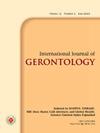Bell's Palsy in Elderly Taiwanese Patients with a History of Peptic Ulcer Disease: A Correlation Study
IF 0.3
4区 医学
Q4 GERIATRICS & GERONTOLOGY
引用次数: 0
Abstract
Background: This nationwide, retrospective cohort study was initiated to investigate the correlation between Bell's palsy (BP) and peptic ulcer disease (PUD). Methods: The Taiwan National Health Insurance statistics were used in this large case-control study to investigate the correlation of BP in patients with a history of PUD. We included 69,340 patients in whom PUD was newly diagnosed between January 2000 and December 2005. The PUD patients were tracked until 31 December 2011 or when BP was first diagnosed. For comparison, 208,020 patients without PUD were randomly selected using a 1:3 case-control matching of age, gender and the year of diagnosis of PUD. The correlation of BP in patients with and without PUD was computed using Cox's proportional hazards model. The cumulative incidence of BP in both cohorts was estimated using the Kaplan-Meier method. Results: Elderly patients aged 65 years or older with a history of PUD had a higher incidence rate of BP (at 1.21 per 1000 persons/year) compared to those without PUD (0.96 per 1000 persons/year). A significantly higher adjusted hazard ratio of 2.5 (95% CI 2.13-2.93; p < 0.0001) was found in this group as compared to patients aged 40-65 years. Conclusions: A significant positive correlation between BP and a history of PUD was observed in elderly patients.台湾有消化性溃疡病史之老年贝尔氏麻痹患者之相关性研究
背景:这项全国性的回顾性队列研究旨在探讨贝尔氏麻痹(BP)与消化性溃疡病(PUD)之间的相关性。方法:本研究采用台湾全民健保统计资料,探讨有PUD病史患者血压的相关性。我们纳入了2000年1月至2005年12月期间新诊断为PUD的69,340例患者。追踪PUD患者至2011年12月31日或首次诊断出BP。为了进行比较,采用年龄、性别和PUD诊断年份1:3的病例对照匹配,随机选择208,020例无PUD患者。采用Cox比例风险模型计算合并和未合并PUD患者血压的相关性。使用Kaplan-Meier方法估计两个队列的BP累积发病率。结果:65岁及以上有PUD病史的老年患者BP发病率(1.21 / 1000人/年)高于无PUD患者(0.96 / 1000人/年)。校正后的风险比显著高于2.5 (95% CI 2.13-2.93;P < 0.0001),与40-65岁的患者相比。结论:老年患者血压与PUD病史有显著正相关。
本文章由计算机程序翻译,如有差异,请以英文原文为准。
求助全文
约1分钟内获得全文
求助全文
来源期刊
CiteScore
0.60
自引率
0.00%
发文量
0
审稿时长
6-12 weeks
期刊介绍:
The Journal aims to publish original research and review papers on all fields of geriatrics and gerontology, including those dealing with critical care and emergency medicine.
The IJGE aims to explore and clarify the medical science and philosophy in all fields of geriatrics and gerontology, including those in the emergency and critical care medicine. The IJGE is determined not only to be a professional journal in gerontology, but also a leading source of information for the developing field of geriatric emergency and critical care medicine. It is a pioneer in Asia.
Topics in the IJGE cover the advancement of diagnosis and management in urgent, serious and chronic intractable diseases in later life, preventive medicine, long-term care of disability, ethical issues in the diseased elderly and biochemistry, cell biology, endocrinology, molecular biology, pharmacology, physiology and protein chemistry involving diseases associated with age. We did not limit the territory to only critical or emergency condition inasmuch as chronic diseases are frequently brought about by inappropriate management of acute problems.

 求助内容:
求助内容: 应助结果提醒方式:
应助结果提醒方式:


